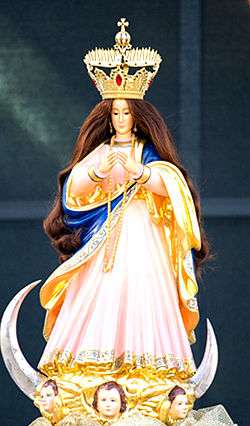Dulce Nombre de Maria Cathedral Basilica

Dulce Nombre de Maria Cathedral Basilica (Spanish: Catedral Basílica del Dulce Nombre de María) is a structure located on the site where the first Catholic church on the United States territory of Guam was constructed in 1669 under the guidance of Padre San Vitores. The present building looms above the palm trees and is a familiar landmark in downtown Hagåtña.
The basilica enshrines the image of Santa Marian Kamalen, Patroness of Guam.
History
The precursor of the present day Basilica was a chapel, or capilla, constructed of rough logs and nipa thatch built within the perimeter of the Plaza de España. The Church was the focal site around which the administrative buildings were built. Built under the direction of Padre Diego Luís de San Vitores, with the assistance of the Chamorros of Hagåtña, it was dedicated on February 2, 1669.[1]:68 Queen Maria Ana donated 300 pesos and Chief Quipuha of Hagåtña contributed the land. In 1670 a more permanent structure was erected. Built of coral stones with the technique of mamposteria, this structural foundation expanded to become the Cathedral. Within this structure were walls, ceilings and floors constructed of ifil wood. A fresco on the rear wall depicted the Assumption of the Blessed Virgin Mary. The original Cathedral was destroyed by bombardment during the retaking of Guam.
According to historian Benigno Palomo, in 1669, one of the main missions of the Spanish soldiers and missionaries was to exalt "the Catholic faith" and that "the people living in islands and land of this sort, you will and ought to bring to the Christian religion", from the Bill of Partition issued by Pope Alexander VI.
Other churches were built at Funa near Umatac, at Tepungan by Asan, at Ritidian, at Tarrague, at Dededo and at Orote. Initially, many of these churches were destroyed by the Chamorros in their effort to regain their independence. Others were destroyed by natural causes. Over the years, the Chamorros gradually accepted the faith of the Spanish as their own.
As time passed, village life centered on the church. Rituals involving birth, transition from adolescent to manhood, marriage and death centered on the church.
Before the war there were nine churches and 22 chapels throughout Guam. These chapels were little sanctuaries between villages where one could privately pray during the long journey to and from home. All were destroyed during World War II except San Dionisio at Umatac, San Jose at Inarajan and San Francisco at Yona.
Today
The Cathedral-Basilica's existing structure has reached its golden age of 50 years after being constructed and dedicated on April 20, 1959. Today, the Cathedral-Basilica serves as local landmark and is home to a community of parishioners who regularly attend Sunday Masses, sacred liturgies and annual events. It is also a place where Guam's visitors embrace the island's rich Catholic history and identity.
On the grounds of the Cathedral-Basilica, visitors will find the Cathedral-Basilica Gift Shop, which sells a variety of souvenirs like rosaries, books, and other things related to the Catholic faith.
National Museum of the Dulce Nombre de Maria
The National Museum of the Dulce Nombre de Maria is located above the Chapel of St. Therese of Lisieux. The museum features changing displays of inspirational art created by local artists.
References
- ↑ Carano, P., and Sanchez, P.C., 1964, A Complete History of Guam, Tokyo: Charles E. Tuttle Company
External links
Coordinates: 13°28′27″N 144°45′09″E / 13.4743°N 144.7524°E
